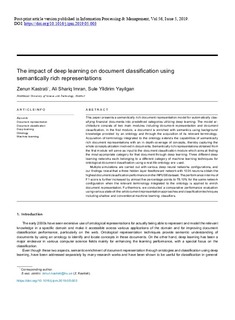| dc.contributor.author | Kastrati, Zenun | |
| dc.contributor.author | Imran, Ali Shariq | |
| dc.contributor.author | Yildirim Yayilgan, Sule | |
| dc.date.accessioned | 2020-01-15T13:48:02Z | |
| dc.date.available | 2020-01-15T13:48:02Z | |
| dc.date.created | 2019-05-07T12:47:50Z | |
| dc.date.issued | 2019 | |
| dc.identifier.citation | Information Processing & Management. 2019, 56 (5), 1618-1632. | nb_NO |
| dc.identifier.issn | 0306-4573 | |
| dc.identifier.uri | http://hdl.handle.net/11250/2636466 | |
| dc.description.abstract | This paper presents a semantically rich document representation model for automatically classifying financial documents into predefined categories utilizing deep learning. The model architecture consists of two main modules including document representation and document classification. In the first module, a document is enriched with semantics using background knowledge provided by an ontology and through the acquisition of its relevant terminology. Acquisition of terminology integrated to the ontology extends the capabilities of semantically rich document representations with an in depth-coverage of concepts, thereby capturing the whole conceptualization involved in documents. Semantically rich representations obtained from the first module will serve as input to the document classification module which aims at finding the most appropriate category for that document through deep learning. Three different deep learning networks each belonging to a different category of machine learning techniques for ontological document classification using a real-life ontology are used. Multiple simulations are carried out with various deep neural networks configurations, and our findings reveal that a three hidden layer feedforward network with 1024 neurons obtain the highest document classification performance on the INFUSE dataset. The performance in terms of F1 score is further increased by almost five percentage points to 78.10% for the same network configuration when the relevant terminology integrated to the ontology is applied to enrich document representation. Furthermore, we conducted a comparative performance evaluation using various state-of-the-art document representation approaches and classification techniques including shallow and conventional machine learning classifiers. | nb_NO |
| dc.description.abstract | The impact of deep learning on document classification using semantically rich representations | nb_NO |
| dc.language.iso | eng | nb_NO |
| dc.publisher | Elsevier | nb_NO |
| dc.rights | Attribution-NonCommercial-NoDerivatives 4.0 Internasjonal | * |
| dc.rights.uri | http://creativecommons.org/licenses/by-nc-nd/4.0/deed.no | * |
| dc.title | The impact of deep learning on document classification using semantically rich representations | nb_NO |
| dc.type | Journal article | nb_NO |
| dc.type | Peer reviewed | nb_NO |
| dc.description.version | acceptedVersion | nb_NO |
| dc.source.pagenumber | 1618-1632 | nb_NO |
| dc.source.volume | 56 | nb_NO |
| dc.source.journal | Information Processing & Management | nb_NO |
| dc.source.issue | 5 | nb_NO |
| dc.identifier.doi | 10.1016/j.ipm.2019.05.003 | |
| dc.identifier.cristin | 1696042 | |
| dc.description.localcode | © 2019. This is the authors’ accepted and refereed manuscript to the article. Locked until 15.5.2021 due to copyright restrictions. This manuscript version is made available under the CC-BY-NC-ND 4.0 license http://creativecommons.org/licenses/by-nc-nd/4.0/ | nb_NO |
| cristin.unitcode | 194,0,0,0 | |
| cristin.unitcode | 194,63,10,0 | |
| cristin.unitcode | 194,63,30,0 | |
| cristin.unitname | Norges teknisk-naturvitenskapelige universitet | |
| cristin.unitname | Institutt for datateknologi og informatikk | |
| cristin.unitname | Institutt for informasjonssikkerhet og kommunikasjonsteknologi | |
| cristin.ispublished | true | |
| cristin.fulltext | postprint | |
| cristin.qualitycode | 2 | |

